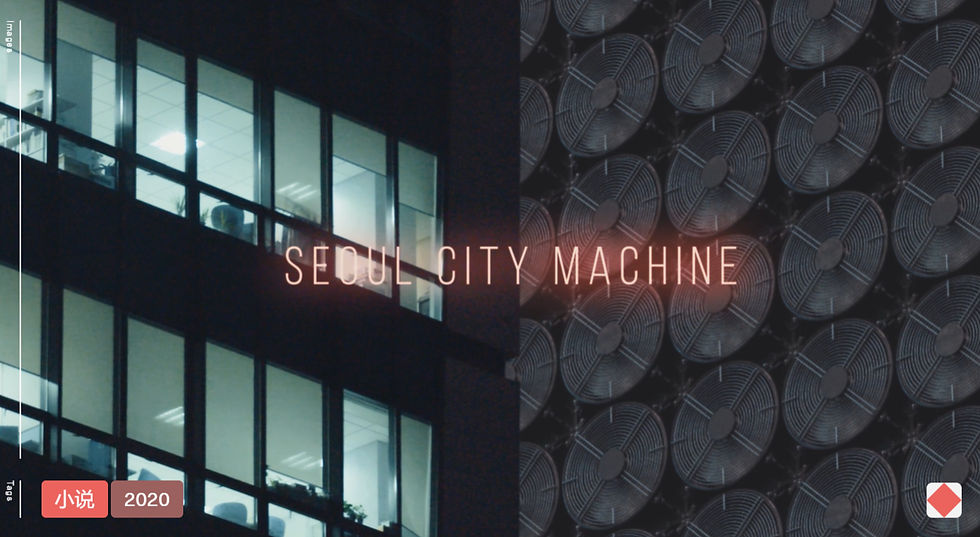The City That Sees: Surveillance, AI, and Power in Seoul’s Urban Future
- Yihan Zheng
- Aug 13
- 4 min read

Figure 1. "a film still" From Liam Young, “Seoul City Machine / Liam Young for the Shenzhen Biennale (UABB) 2019,” ArchDaily, May 23, 2019
"Seoul City Machine", created by Liam Young, was part of the main section of 2019 Shenzhen Biennale of Urbanism\Architecture (UABB), themed "Eyes of the City", exploring the evolving relationship between urban spaces and technological innovation. Curated by Carlo Ratti, the exhibition invited designers to present their visions on how artificial intelligence and other technologies might transform architecture and urban life. The concept of "Eyes of the City" refers to the ability of urban environments to 'see' through electronic devices, integrating sensors and cameras to collect and analyze data in real-time.This essay argues that while these advancements offer promising benefits, they also raise significant ethical and societal concerns, particularly regarding surveillance and power dynamics.
Therefore "Seoul City Machine," a city symphony film, offers a glimpse into the future urban landscape, scripted and narrated by an AI chatbot trained on smart city data. By personifying the city, it serves as a love letter from the City Operating System to its citizens, portraying a city where machines and technology are the primary inhabitants of space. The disembodied voice of the urban management software guides us through the city, presenting a series of abstract vignettes, fragments, and moments where emerging technologies have fully materialized. The film uses contemporary Seoul as its backdrop, overlaid with cinematic visual effects to depict an autonomous world of drones, driverless cars, and augmented reality.
Seoul was chosen as the setting for "Seoul City Machine" due to its rapid economic and technological development. The transformation of Seoul from a war-torn city to a leading global metropolis is a result of strategic government initiatives. Since the 1960s, South Korea has experienced rapid industrialization and urbanization, known as the "Miracle on the Han River." This period saw massive infrastructure projects and the rise of chaebols (large family-owned business conglomerates), which reshaped Seoul's urban landscape. The city's extensive use of technology in urban management, from smart transportation systems to energy-efficient infrastructure, made it an ideal location to explore the future of urban environments through the lens of AI.

Figure 2. "a film still" From Liam Young, “Seoul City Machine / Liam Young for the Shenzhen Biennale (UABB) 2019,” ArchDaily, May 23, 2019
Seoul’s transformation is deeply intertwined with historical political processes. The rapid industrialization and urbanization efforts led by the government prioritized economic growth and modernization, resulting in significant social and environmental challenges. These included increased stress on urban infrastructure, environmental degradation, and social inequality. The democratization of South Korea in the 1980s and the economic reforms following the Asian financial crisis in the late 1990s further influenced Seoul's development trajectory. These historical and political evolutions are reflected in the design of "Seoul City Machine," portraying a future where AI and machine vision play a central role in urban management. This not only highlights the potential benefits of technological advancements but also the anxieties and ethical concerns associated with rapid development.
The project intersects with societal debates on surveillance, data privacy, and the ethical use of AI in public spaces. By depicting a city under constant observation by sensors, cameras, and satellites, it prompts discussions on the balance between technological benefits and individual privacy rights. Moreover, the film raises critical questions about the power dynamics between citizens and urban management systems, urging us to consider how these technologies might influence social structures and governance. The portrayal of AI-driven urban environments serves as a cautionary tale, highlighting the need for thoughtful integration of technology into our cities.
Based on the current political scenario, although the film lacks subjective coloring, I believe that without interference from other organizations or departments, chaebols could inevitably control city management and data surveillance to exploit the populace more effectively. This concern is not merely speculative but a potential warning. As South Korea has transitioned from dictatorship to democracy, there is a legitimate fear that these technologies could reverse this progress, or at least that is the concern of both the chaebols and the government. This historical pattern suggests that unchecked power could lead to exploitation and control.

Figure 3. "a film still" From Liam Young, “Seoul City Machine / Liam Young for the Shenzhen Biennale (UABB) 2019,” ArchDaily, May 23, 2019
"Architecture must relate to our impressions of ourselves and our social, psychological, and societal status." "Seoul City Machine" encapsulates this philosophy by envisioning a future where urban environments are intricately connected with advanced technologies, reshaping our perceptions and interactions within the city. Through its speculative narrative and innovative use of AI, the project not only offers a vision of the future but also invites critical reflection on the ethical and societal implications of these technological advancements. As we move towards increasingly automated and interconnected urban spaces, projects like "Seoul City Machine" remind us of the importance of maintaining a human-centered approach in the midst of rapid technological change. And this caution is not only relevant to Seoul but serves as a global warning to rapidly developing cities and countries: to pay attention to societal debates and prioritize human-centered technological development.This essay argues that while these advancements offer promising benefits, they also raise significant ethical and societal concerns, particularly regarding surveillance and power dynamics.


Comments